Saguaro
Carnegiea (Cereus) gigantea
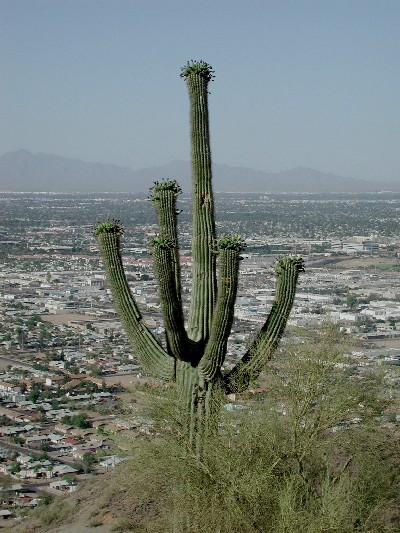
The vast desert metropolis of Phoenix, Arizona, appears below this saguaro perched on the slopes of Shaw Butte, part of the Phoenix Mountain Preserve. This June 2002 photo shows clusters of green fruit near the arm tips.
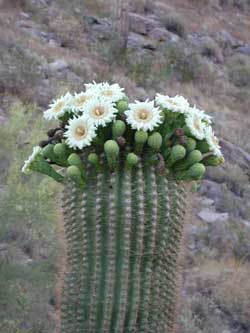
Blooming from May to June
On your hikes through the Sonoran Desert there is a chance that you will find
the calling cards of Cactobrosis fernaldialis! In the photo below are
two examples of these curious objects that are clearly of botanical origin but
seem to have a most curious shape without obvious purpose. These heavily
calloused structures were left behind after a saguaro had long died and rotted
away. They were originally formed by the cactus in defense against the
tunneling caterpillar of a Cactobrosis moth. Just before a caterpillar reaches
maturity it chews an escape hatch through the outer cortex of the saguaro -
this is the origin of the flattened disc structure (right) seen at one end of
the callus. If you examine living saguaros these scars are commonly found on
the surface.
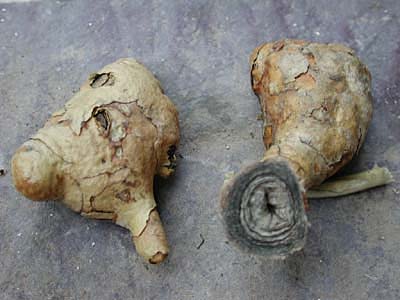
Calloused galleries created by Cactoborsis larvae:
The callus on the left offers a curious twist in that the "escape hatch" is
missing. Something killed the larva before it completed its development and
before it could create the hatch. Most likely this was a parasitic wasp. The
wasp matured within the Cactobrosis but used an alternate method of
escape. Other calloused structures are also left behind after a saguaro has
disintegrated. The most familiar is called a "saguaro boot". Once a gila
woodpecker has hollowed out a nest, the saguaro heals over the injury creating
a tough boot-shaped structure. Heavily impregnated with lignin it resists decay
and can offer nest holes to hundreds of birds through the life of the cactus.
UNMISTAKABLE: The Saguaro Cactus is unmistakable, at least within
Arizona. One of the Barrel Cactus species might look like a young, unbranched
saguaro cactus, except for the barrel's larger circumference than a saguaro of
the same height. But, also, the
SPINE CLUSTERS are different: the saguaro has about 20 straight and
similarly textured spines whereas the barrel cactus species have one stiff
curved spine, 3-5 straight stiff spines and a dozen or more soft flexible
spines.
RANGE: Southwestern third of Arizona, western Sonora, and a few small
areas in southeast California near the Colorado River. On south facing slopes
the saguaro cactus occurs up to 1500 m elevation which is considerably
higher than the 960 m upper elevational limit of the Sonoran Desert as
defined by Shreve (1951). I believe that cold-hardiness has been increasing
within the saguaro gene pool thus permitting its migration north and upslope.
FLOWERS: 12 cm or more in diameter with many white waxy petals. Numerous
yellow stamens form flower center.
FRUIT: The bright red flesh of the fruits is exposed as the fruits begin
splitting open after the third week of June. They peel open along the carple
seams giving the look of a new set of red flowers.
Cactaceae -- Cactus Family
Sponsored Links:
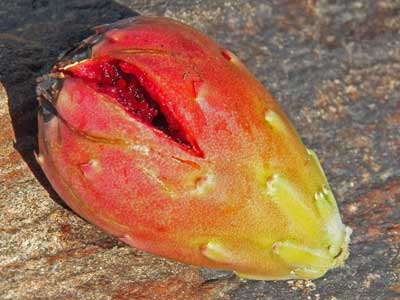
Hundreds of small black seeds are embedded in each bright red, juicy, fruit.
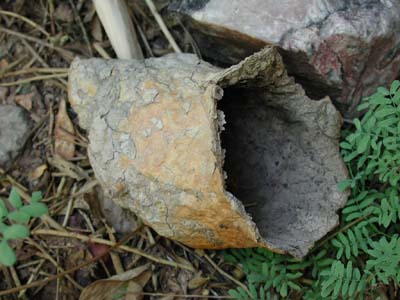
A Saguaro Boot, a former Gila Woodpecker nest hole.